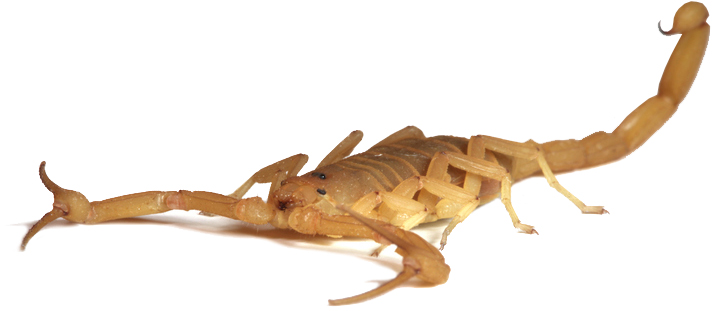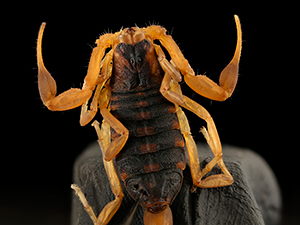 The heat is on, and so is the pressure from hard-to-kill pests that thrive in higher temperatures. Spiders and scorpions are top of the list when it comes to pests that invoke fear in our customers.
The heat is on, and so is the pressure from hard-to-kill pests that thrive in higher temperatures. Spiders and scorpions are top of the list when it comes to pests that invoke fear in our customers.
Even seasoned techs will admit that arachnids give them the “heebie-jeebies” when sharing tight attics and crawl spaces with them. And given that some spiders and scorpions can actually hurt us, it is only reasonable to have a healthy respect for them. It is no surprise that these eight-legged pests are a leading cause of calls from customers looking for a competent pest management professional (PMP).
Understanding arachnid biology and treatment techniques, and having an effective product in your tank can make the difference between being a boxer on the ropes or a champ with a knockout left hook. Here are a few helpful facts every PMP should know.

Arizona bark scorpion. Photo: ©istock.com/Srabin.
Scorpions

Bark scorpion (Centruroides sculpturatus). Photo by USGS Bee Inventory and Monitoring Lab, used under public domain from Wikimedia Commons.
A scorpion sting can be as mild as a bee sting or a life-threatening experience depending on the species found in the region where you operate. Most are painful but harmless, with the exception of the bark scorpion (Centruroides sculpturatus) found in the desert Southwest. Regardless, scorpion sightings inside a home are never welcome and are sure to make the phone ring.
Scorpions are, by definition, hard to kill. Two factors that contribute to their hardiness are their thick exoskeleton and cryptic behavior.
The exoskeleton of scorpions is one of the toughest in the arthropod world: a thick waxy armor designed to survive scorching heat with long periods of little to no moisture. Not much gets through this tough barrier.
In the mind of a scorpion
When making residual and contact applications, it is important to think like a scorpion. During daylight hours, most scorpions are tucked away in hiding spots where their low metabolism and inactivity allow them to go long periods without feeding. Therefore, crack-and-crevice applications along landscaping timbers, decorative stone and other structures in the yard must not be overlooked.

Crack-and-crevice applications must not be overlooked. Photo provided by Bayer.
While scorpions like to sit and wait for an unsuspecting meal to wander by during the day, at night — during the heat of summer — scorpions “make hay” and aggressively hunt for live insects. During these expeditions, they usually find openings into a home or business under worn out door sweeps or other gaps.
Sealing homes is a common business for PMPs in areas with high scorpion pressure. However, in most situations, a thorough barrier around the home with a strong residual will prevent an indoor scorpion infestation.
The tool for take-down:
The power of the Temprid FX co-milled formulation is specifically designed for hard-to-kill pests. Only a trace amount of the fast-acting formulation needs to penetrate the membranes between the plates of scorpion exoskeleton for knockdown. The kill is quick for both direct exposure and movement across residual barriers. The key to success is the fast combo punch of two powerful active ingredients.
Video provided by Bayer.
Web-building spiders
Web-building spiders use webbing as a trap to catch their prey. These spiders, like other arachnids, spend their daylight hours hiding in a cozy crack or crevice somewhere very near the web.
While no spider is welcome in a home or business, it’s these crafty web spinners that usually have technicians scratching their heads despite hard work removing webs with a duster.
When webs are removed, but the spider is left alive, it will likely rebuild the next day.
Hit them close to home
Despite a relatively thin exoskeleton, these spiders are hard to kill because of their ability to hide. To take them out, you need to spray directly into their hiding spot as they will not rub their body across surfaces that receive a general treatment.
Structures have countless places where they can hide, but there is no need — or enough time in the day — to thoroughly treat every crevice on an eave line or the entire weep screed. Unwitting spiders leave us a huge clue to the location of their lair: the web!
It is very important to make crack-and-crevice applications to all potential harborages within a foot of any web. Be sure to do this before you remove the webs or you won’t know where to start. With funnel-web and many other cobweb-producing spiders, you’ll notice a web-lined entrance to their hideout.
The tool for take-down:
A fine low-pressure shot of Temprid FX into that opening and spiders will be down for the count! And, the long-lasting residual of Temprid FX will make sure that hideout remains spider-free for the rest of the season.
Take a tip from the arachnids and “make hay” this summer. It’s a great time to build your route — and the trust of your customers — through effective and professional service.
Video provided by Bayer.
Want to know how much you could save by simplifying your operations and reducing costly retreats? Download the new Temprid eLearning Module Value Calculator and see the difference Temprid could make for your bottom line.
For more information about Temprid FX by Bayer, visit www.backedbybayer.com.

Bug illustrations. Image: Bayer.
Article content was contributed by Dr. Eric Paysen, Bayer PPM Area Sales Managers for the western region of the U.S and adjunct member of the Bayer Pest Practices team.
This page was produced by North Coast Media’s content marketing staff in collaboration with Bayer. NCM Content Marketing connects marketers to audiences and delivers industry trends, business tips and product information. The Pest Management Professional editorial staff did not create this content.
Photos: Bayer; ©istock.com/Srabin; Header photo by Larry Crist / USFWS [CC by 2.0] from Flickr.com.